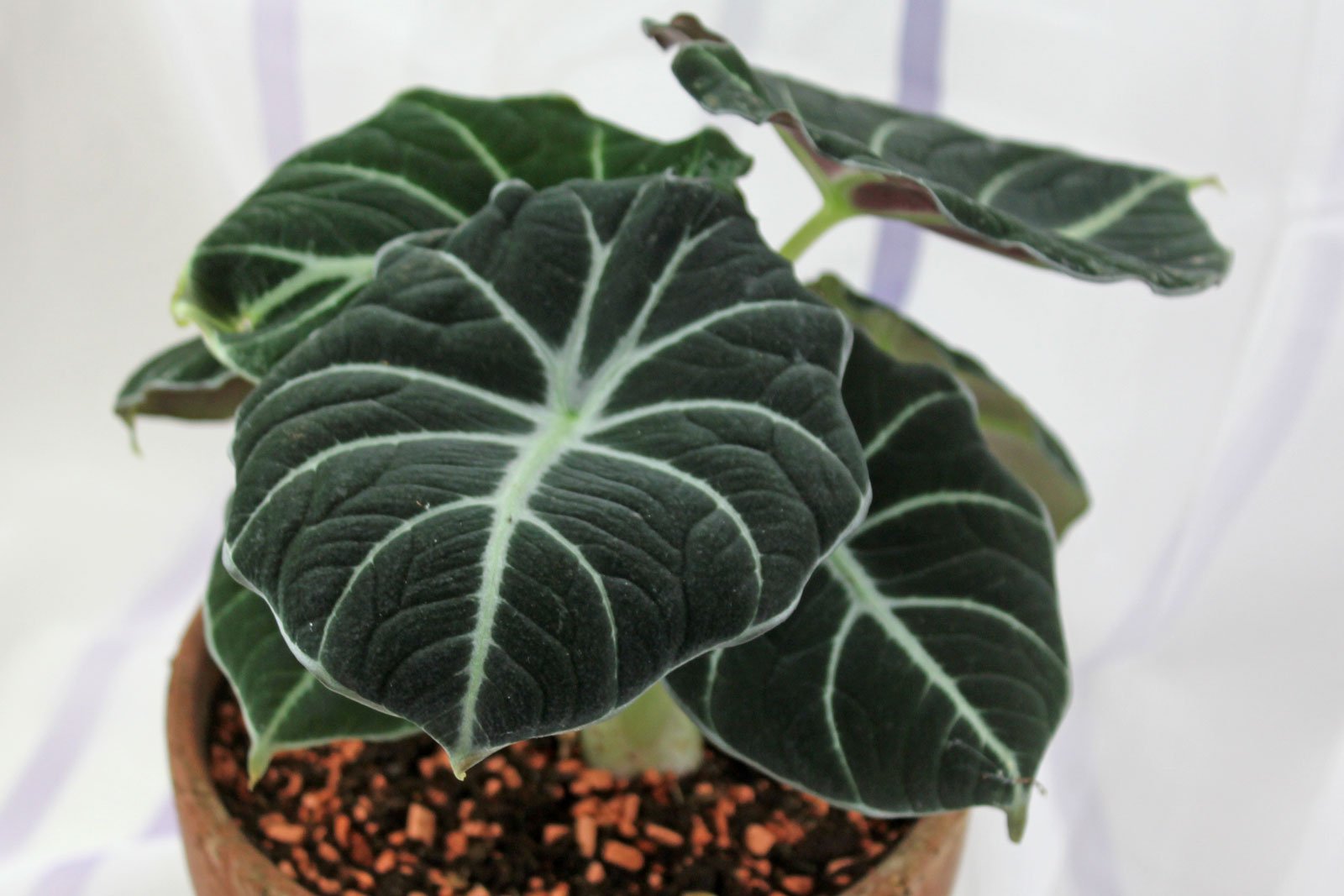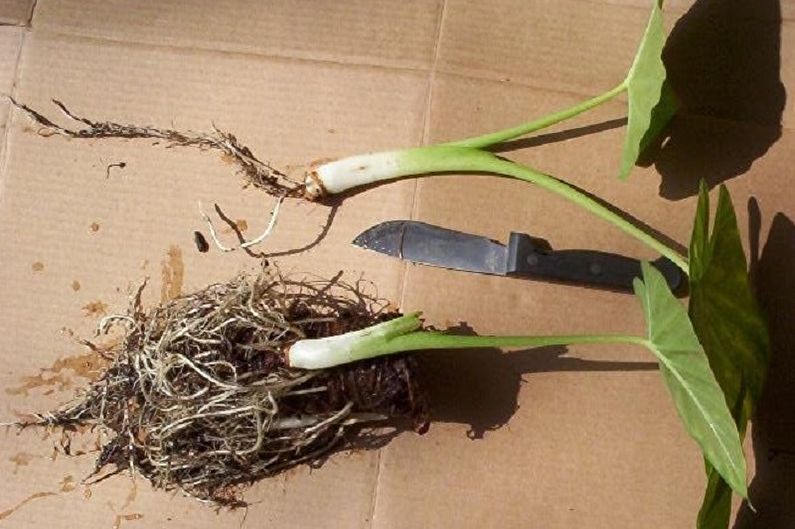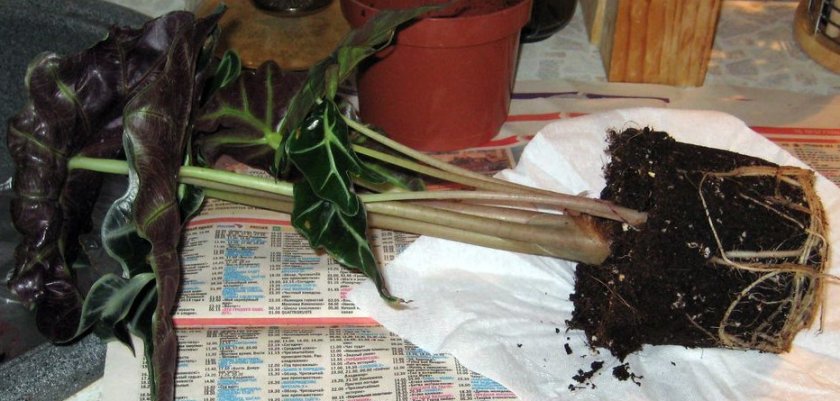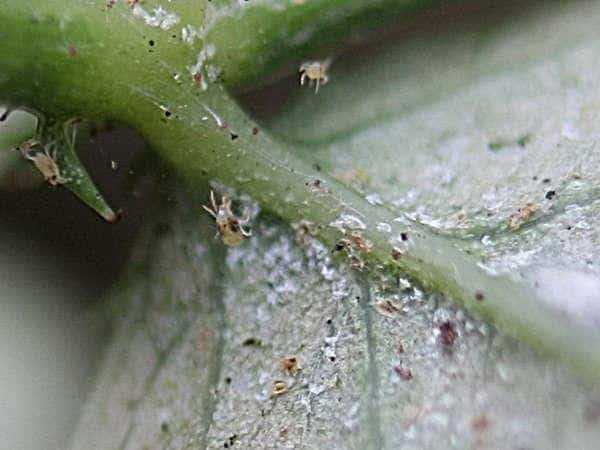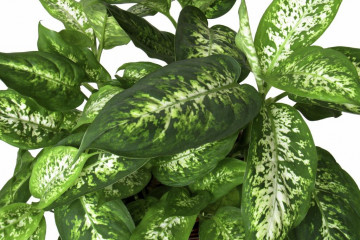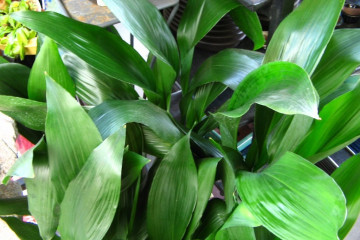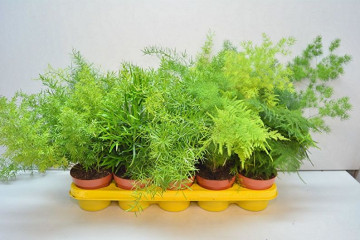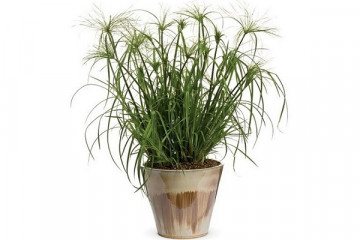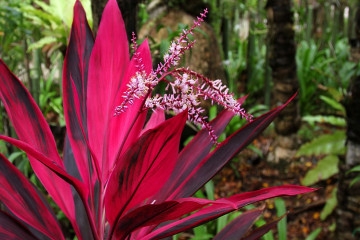Alocasia flower - home care
Content:
In nature, alocasia grows in the tropical forests of Southeast Asia, Malaysia, and Ceylon. In home cultivation, the crop is valued primarily as a deciduous plant, because it is rather difficult to achieve its flowering.
Plant characteristic
Belongs to the Aroid family, which today has united about 70 species. Alocasia is an evergreen large-leaved plant that has the following features, depending on the species:
- Has a trunk or stemless.
- Grows from 30-40 cm to 2 meters in height.
- The forms of dense leaf plates are oval, thyroid, cordate, up to a meter in length.
- The root system is of the tuberous type.
Work with the plant should be carried out in compliance with safety rules, its placement should be inaccessible to children and pets.
In nature, after heavy tropical showers, at home, with excessive watering, the leaves of alocasia begin to emit water droplets.
Domestic alocasia is a plant used to treat many diseases. The therapy is carried out using alcoholic tinctures of certain varieties of culture. In Chinese traditional medicine, its magical properties have long been used. Flower phytoncides perfectly clean the air of the room.
Common varieties
Professional flower growers grow various flowering varieties in greenhouses. Ornamental culture looks spectacular both singly and in compositions with other plants.
- Alokazia Black Velvet stands out for its unique color, reminiscent of dark green corduroy, with silvery leaf veins. The maximum height is no more than 60 cm.
- Alocasia Amazonica (Alocasia amazonica) with pinkish-green petioles half a meter long, thyroid leaves up to 20 cm wide and up to 50 cm long can bloom in very rare cases. Alocasia Amazonica on a low peduncle forms a flower about 10 cm long, covered with a greenish veil.
- Alocasia Sandera (Alocasia sanderiana) is more often cultivated in the greenhouse. The roots are tuberous, on brownish-green petioles 25-50 cm long are green arrow-shaped leaves 40 cm long and up to 15 cm wide.A bright representative of this dwarf variety - alocasia Bambino - is distinguished by narrow elongated spear-shaped leaves, its flowers are white-purple.
- Alocasia large-rooted (Alocasia macrorrhizos - macrorisa), or Indian or Arma (Alocasia indica), the height of the trunk reaches 2-3 meters, the length of the petioles is one meter, it has heart-shaped leaf plates up to a meter long and almost the same width. Peduncle up to 30 cm long, where the ear is covered with a greenish-yellow veil, is inconspicuous and fragrant. Alocasia large rhizome is also used as a medicinal plant.
- In alocasia odora (Alocasia odora), petiole leaf plates are linear-ovoid in width up to 70 cm, up to a meter in length at the base are divided. Flowers have a specific smell. The plant has healing properties - Chinese healers use indoor flower for stomach and toothache, pneumonia and tuberculosis. But it is not recommended to treat yourself in this way.
- Alokaziya Kalidora (Calidora) is distinguished by large wrinkled leaves.This is a hybrid form, obtained by crossing the varieties of odorous and gageans, reaches a growth of more than 2 meters in height. The foliage is dense, thick about a meter in length.
- Alocasia polly (polly) is a short plant (up to 70 cm) with a short stem, dark thyroid-shaped foliage up to half a meter long, up to 20 cm wide. Foliage with whitish veins, has a metallic shade, jagged edges and end. Polly alocasia, if home care was optimal, can bloom much more often than other varieties.
- Alocasia lauterbachiana was discovered by the German naturalist Karl Lauterbach in New Guinea. It has strongly elongated champlevé leaves of a dark green color, with a burgundy tint on the back. The cuttings and inflorescences of the variety differ in the same shade. Alokazia Lauterbachiana grows up to 70 cm.
- Alocasia Dragon is short, with light green heart-shaped leaves and dark veins on them.
Many species are quite difficult to purchase for home breeding, some of them are not cheap - Kukulata, Corazon, Sarian, Kupreya - from several hundred to several thousand rubles.
Features of home care
Alocasia tropical culture prefers home care as close as possible to natural.
- Lighting
Bright, but diffuse for variegated species, slightly darkened for green-leaved species. The windowsills of the western and eastern directions are optimal, if the windows are south - the plant needs to be shaded.
- Watering
During the growing season, abundant watering with soft settled water, but only after the topsoil has dried out. In the autumn period, a gradual reduction and during the rest period - moistening 1-2 days after the soil surface dries.
- Room temperature and humidity
In the spring-summer period 20-27 degrees, in the winter period - 18-20. Elimination of drafts, sudden temperature changes.
High air humidity, systematic soil moistening by wiping, spraying. On very hot days, you can put damp pebbles or expanded clay into the pallet.
- Soil and dressing
During the growing season (spring-summer-autumn), fertilizing with complex mineral fertilizers for decorative deciduous crops and organic matter every 2-3 weeks. It is important not to overdo it, fertilizers must be diluted, reducing the concentration by 2-3 times.
The soil mixture should consist of coniferous, leaf and peat soil and sand (coconut shavings, sphagnum - for aeration, soil permeability), add a handful of charcoal. Acidity - weak pH 5.5.
Plant pruning is almost not required. Dead dried leaves are removed with pruning shears to healthy tissues, the cut site is treated with charcoal.
Features of care during the rest period
It starts in mid-autumn (October) and ends in early spring (late February - early March). In the fall, yellowed leaves must be removed, the plant must be removed from the windowsill to a moderately lit place, and watering must be gradually reduced.
The temperature of the content for the winter should be about 20 degrees. In the spring, the usual care is gradually resumed.
There are varieties that do not go into complete rest, continue to grow to a partial strength. Therefore, in the winter period, it is possible to continue fertilizing and watering the plant, occasionally and in very small doses.
How alocasia blooms
Flowering occurs in the spring, and in very rare cases:
- possible only in mature alocasia (4-5 years);
- when creating the most suitable microclimate in the room at home;
- if from the beginning of spring you briefly dry out the earthen lump, this will start the mechanism of tying a flower bud.
The inflorescence is a white, cream-colored ear, surrounded by a veil, located on a dense, shortened peduncle. Bright red fruits ripen on it. During the flowering period, foliage slows down growth, partially falls off.
How alocasia multiplies
There are several ways of reproduction - stem cuttings, division of rhizomes, daughter tubers, seeds.
Seed propagation is an inconvenient method because:
- seeds very quickly lose their germination;
- varietal traits (variegated foliage) are not preserved with this method.
The seeds are spread over the surface of a soil mixture consisting of peat and sand, slightly pressing, covered with a film (glass) and removed to a warm place (22-24 degrees). Ventilate regularly to get rid of condensation, moisten the soil. After the seedlings appear and get stronger, they will acquire 2-3 leaves, they are dived into separate pots with a diameter of 7 cm. A year later, they are transplanted into a pot with soil for an adult plant.
Sometimes alocasia is divided by planting tubers during transplantation. First, the roots are soaked in water, freed from the ground and the plant is divided into parts with a sharp knife, carefully separating it from the mother bush, then germinated in sphagnum at a temperature of 23 degrees.
When dividing the rhizome and harvesting cuttings from the stems, the cut or rhizomes must be treated with chopped charcoal and left for 2-3 hours. Then plant the seedling (stalk) in a substrate of peat and sand, cover with a film (glass), place at a temperature of 22-24 degrees, regularly ventilate and water.
Alocasia transplant
At a young age, a culture is transplanted annually, an adult plant - every 2-3 years. The most favorable period for this is spring.
The pot is chosen deep, 2 cm larger than the old one. Drainage is laid at its bottom, then soil consisting of leaf, peat, coniferous soil and sand. Another option is turf, humus, leafy soil, sand and peat. A handful of charcoal in the soil will save the roots from retaining excess water.
The largest specimens are transplanted by the transfer method - the plant is pulled out of the old pot with an earthen clod, placed in a new pot for drainage and sprinkled with new soil on all sides.
Pests and diseases
Weakened by excessively dry air, high temperature, alocasia, the proper care of which has been violated, can be colonized by scale insects, spider mites, aphids, mealybugs. Previously, the leaves and stems are wiped with a soapy sponge, if it does not help, with Actellik's solution (1-2 ml per liter of water).
Containment-related illnesses:
- Slow growth during the growing season indicates a lack of nitrogen.
- Foliage withering can be associated with both a lack of moisture and waterlogging of the soil. It is necessary to optimize watering, the composition of the soil mixture, so that moisture does not stagnate. If the leaves turn yellow and fall off one at a time, this is a normal renewal process.
- Drying of the tips of the leaves indicates a low level of air humidity, scarcity of watering.
- Fading foliage indicates a lack of light.
- The formation of dark spots on foliage due to a sharp change in temperature.
- Brown spots on the leaves are signs of hypothermia of the flower.
Despite the attractiveness and variety of species, alocasia is currently only gaining popularity in home breeding.This exotic miracle, a magnificent deciduous ornamental plant, looks worthy in light halls and foyers, in winter gardens, near fountains and reservoirs. Taking care of a plant, according to most gardeners, is easy and interesting.
